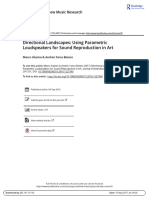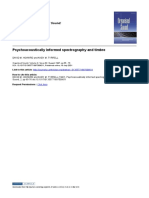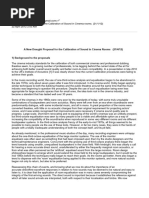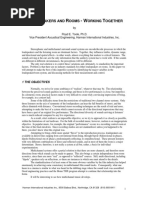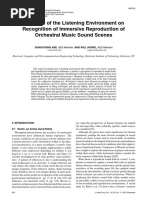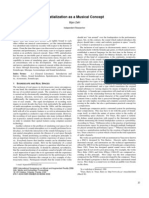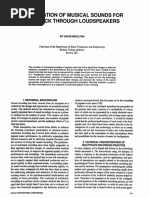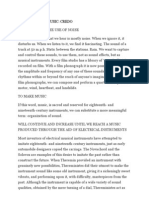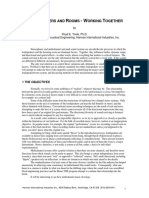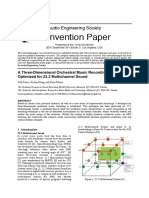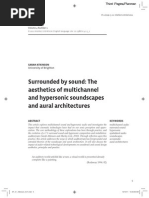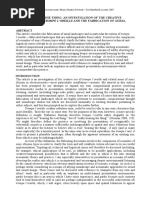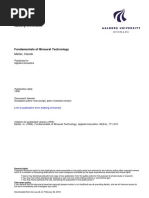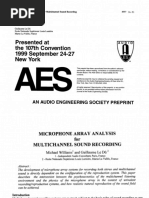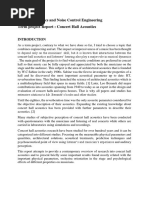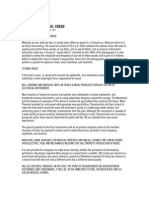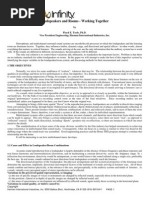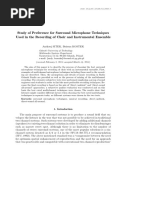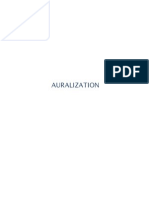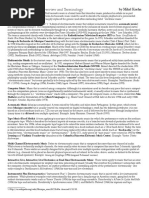Imt 1
Imt 1
Uploaded by
Gary EickmeierCopyright:
Available Formats
Imt 1
Imt 1
Uploaded by
Gary EickmeierOriginal Title
Copyright
Available Formats
Share this document
Did you find this document useful?
Is this content inappropriate?
Copyright:
Available Formats
Imt 1
Imt 1
Uploaded by
Gary EickmeierCopyright:
Available Formats
An Image Model Theory for Ster eophonic Sound
Gary C, Eickmeier
Independent Industrial Designer Lakeland, F L
Presented at
the 87th Convention 1989 October 18-21 New York
2869 (A- 3 )
This preprint has been reproduced from the author's advance manuscript, without editing, corrections or consideration by the Review Board The AES takes no responsibility for the contents
\dditional preprints may be obtained by sending request and remittance to the Audio Engineering Society, 60 East 42nd Street, New York, New York 10165, USA
All rights reserved Reproduction of this preprint, or any portion thereof, is not permitted without direct permission from the Journal of the Audio Engineering Society
AN AUDIO ENGINEERING SOCIETY PREPRINT
lIN IMAGE M:OEL THErlRY. FOR STEREOPHCNIC SOUND
scale, acoustical, field-type reproducing system in which all sound fields present in the original are physically reconstructed in the play tack acoustic. The reproduction is seen as a 3-dimensional rrodel of live sound, as opposed to a wavefront or porta ling process" The major change in practice is that reflected sound is incorporated into the construction of the stereo image ..
GaJ::y c., Eickmeier
independent industrial designer
We will see the irrplications of this as we proceed, but first a review of the history of auditory perspective is in order, to better illustrate how the new theory differs"
A new theory for stereophonic sound is presented as background for a loudspeaker current.ly under development. The theory uses image modeling to visualize all sound fields present in the live performance: direct, early reflected, and reverberant. The reproduced sound will be most like the original when the image mc:del of the reproduction soundfield matches that of the live sound. The model enhances understanding of perception of the spatial qualities of reproduced sound; is a basis for loudspeaker design, positioning, and acoustical requirements of the room; and extends to techniques for the original recording
The first and most basic type of auditory perspective was actually binaural.
This paper has nothing to do' with binaural sound, but since both Harry F" Olson and William B. Snow cautioned us that the terms binaural and stereophonic tend to be continually con£used with each other, perhaps a brief definition would be good.
Olson has defined the two systems as follows: "Binaural is a closed-circuit type of sound reproducing system in which two microphones, used to pick up the original sound, are each connected to two independent corresponding transducing channels which in turn are coupled to two independent corresfX)nding telephone receivers worn by the listener. A stereophonic sound reproducing system is a field type sound reproducing system in which two or more microphones, used to pick up the original sound, are each coupled to a correSpOnding number of independent transducing channels which in turn are each coupled to a corresponding number of loudspeakers arranged in substantial geometrical correspondence to that of the microphones." [3] Snow comrrents that "It has been aptly said that the binaural system transports the listener to the original scene, whereas the stereophonic system transports the sound source to the listener-s room .. "[4]
By now most of the technical aspects of sound recording and reproduction are well in hand. We have sufficient accurscy and flexibility in our transducers, amplifiers, and storage media to do most anything we want, and yet more often than not the sound still lacks the realism of a live performance. It is my belief that the most fundamental aspect of the process, stereophonic theory itself, is not yet complete and correct. This can lead to incorrect practice at both ends of the process (recording and reproduction), false goals as to what can be achieved with stereophonic sound, and research paths that. turn out to be dead ends when trying to irrprove the situation.
It would be worthwhile at this point. to emphasize the difference between a closed-circuit type system (binaural) and a field type system (stereophonic) as used in the above system definitions. Binaural reproduction is meant to isolate the listener from his actual acoustic environment and to isolate the two channels from each other by presenting the sound directly to the ears by means of headphones. The recording was made with a binaural head placed in the "best seat in the house," where it could hear both the music and the corrplete acoustic environment from that poai.t.i.on The system requires each ear to receive exactly the same signals that irrpinged upon the binaural head during recording.. With the stereophonic system the microphones are placed much closer to the orchestra, recording the sound that exists in the region closer to the instruments rathex than that which ....::luld occur near a typical listening position. This means that the recording contains correspondingly less of the concert hall acoustic and more of the direct and early reflected sound from the region of the proscenium. The recording is reproduced on loudspeakers which are placed at a distance from the listener, the entire process taking place in an acoustic space which is different from that in which the recording was made. The resultant sound depends on the new acoustic surroundings to impart acoustical qualities required for good sound [5].
This paper will introduce a new theory for stereophonic sound. It is present.ed as a nudel which can be used to study all aspects of the recording and reproduction process. It is based on a concept from architectural acoustics called image modeling, which is simply a way of stUdYing the incident angles, intensities, and so on of a sound source and all acoustic images of that source in a given acoustic space. Instead of drawing·· ray traces for the .reflected sound, you draw the virtual images of the source as additional sources behind the reflecting surfaces [1,2]. This technique gives a more visual understanding of what it is that we are actually hearing. To be more specific, what is meant by the image model is not just the positions and intensities of the virtual images, but all of the spatial, spectral, and temporal characteristics that are essent.ial {audible) components of the model
It is poas.ib'Ie to make a drawing of the image model of musical instruments in a concert hall or loudspeakers in a play tack room. Image model theory, then, can be stated as fo11ONS: The reproduction will be most like the real thing when the image model of the reproduction soundfield comes as close as possible to that of the original.. This seemingly innocuous statement is in fact a big change in the way that we think about the process.. Stereophonic sound is seen as a large
A conmon-sense way of stating all this is that with binaural we are
2
recording and reproducing ear signals, whereas with stereo we are reproducing the orchestr-a itself, and the soundstage surrounding it, on a macroscopic scale in the playback room. The channels will blend with each other acoustically, and both ears are free to hear both (or all) speakers. We are neither isolating the channels from each other (at the ears) nor the listener from the playback room. Rather, we are using the acoustics of the playback room to reconscruct the sound field around ham. The listener then experiences the total sound field, rather than having individual channels piped to his ears. The confusion between the two systems arises when people begin to believe that the object of "accurate" stereophonic reproduction is to get the sound that went into the microphones straight to the listener - sears, or (worse) that the sound from each speaker Should be heard by only the respective ear, with all interaural crosstalk eliminated ..
or a line of speakers, They are' b l i.nd" to the effects of loudspeaker radiation pat.ber n , positioning, and zoom acoustics. II/e started with the system definition as a field type system, reproduced in a real acoustic space hy loudspeakers, but as far as the ~tion of how it works goes, the playback r'oom might as well not exist, and nowhere do we find reflected sound incorporated as part of stereo theory ..
The best way to illustrate this highly conceptual problem is with an analogy ..
rhe binaural system is straightforward and uncontrOVeJ:sial enough, but the stereophonic system, even at the most fundamental theoretical level, is still undeveloped. To be more specific, lateralization has been discussed in great detail and related unequivocally to the intensity or time difference of the direct sound from two Loudspeakers, IocaUzation and spatial impression have not. Entire classes of auditory cues necessary for localization in enclosed spaces, as discussed by Benade, Maul ton and FerTalli, have been omitted from reproduction with the usual stereo arrangement [6,7).. '!:he body of knowledge from architectural acoustics as to what causes good sound in a concert. hall is temporarily sidestepped when we atterrpt to reproduce the original sound field as a high direct field from two point sources, with no explanation as to how we are supposed to regain those qualities [8,2,9, p3481. Many maverick products exist in the marketplace to address some of these problems, but none of them is as yet a part of an overriding stereo theory in any scientific or engineering sense ..
Many people have used the 'bri.ck wall' analogy - that stereo is something like punching out two holes in a brick wall. separating you from the performance .. Some writers widen the two holes and join them together, some claim that theil: systems knock down the entire wall, but we are always witnessing the sound through a large portal, standing on the outside looking in,
That-·s a good starting point, and a nice, simple analogy to make the desired poi.nc , but let-stake it one step furtheJ:, Imagine yOUJ: listening room plunked down in the middle of Symphony Hall with you in it. We-re going to punch out fil:st two holes (or a portal) in front of us, to "let the music in." Then, the su=ound sound devotees will punch out some ITDre holes in the rear and perhaps side walls, to let all the ambience in. Under the "accuracy" banner, we say that when the reproduction chain gets good enough, the sound will be indistinguishable from this punched-out shell of a room, with nothing between you and the music but. ai.r.
3
4
It is difficult, therefore, to review the present state of stereophonic theory because there is no single theory, written d= in so many words in textbook form. However, fr-om the many art Ic.les that have been written and from the practice of stereo certain trends can be inferred.
The caution at this point is that this would all be very fine thinking except that, no matter how many channels we have, we will never quite make it all the way because, in this analogy, we must remenUJer that the sound can get into the imaginary room, but it. can- t get out, and so the sound still bounces around the listening room with the time between reflections of the smal Le.r space ..
From the Bell labs "curtain of sound" theory stereophonic sound is seen as a wavefront that can be approximated by two or three speakers (and correspondi.nq microphones)'[3,4]. From Blurnlein, stereo is thought to be a microscopic (as opposed to macroscopic, or large scale) process wherein a coincident. pair of microphones encode the direction of all arriving sounds by meal'S of intensity, and the loudspeakers deliver those signals to the listener-·s ears so that the original sound field might be perceived at the listener-·s head [10,11] ..
rhe trend to note with both of these versions is that stereo is thought to operate as a sort of wind.cwing or portaling process wherein the sound that was recorded is simply being relayed to the listener by the reproduction chain. Stereophonic sound is thought to be a "t.r ick" that atterrpts to fool the ears into hear'inq all audible spatial properties of live sound strictly by rreans of lateralization - like looking through a portal into another acoustic space. The degree of success of the illusion is thought to depend on the "accuracy" of the system, and the status of stereo theory as we know it. tcday can be thought of as a search for· greater and greater accuracy ..
The main point of this section, however, is that this is not a good analogy at all,
Notice also that the above descriptions are stJ:ictly two-dimensional processes. The theories are based only on the direct sound radiated from a pair
Many people, especially audiophiles, have the impression that the recording contains. a perfect image of the performance as witnessed from the best seat. in the house, This may be true with binaural, but stereophonic is a very much different process. The problem with the above analogy is that it pictures the sound as having been "witnessed", or recoJ:ded, from the vantage point of the listener in the room suspended in the middle of the concert hall, This is not the case, What we have done is dispatched the microphones up to the orchestra, recorded the musicians and the soundstage surrounding them, and brought back the sound to be played again from entirely within our room, not from outside with holes punched in the walls so we can hear it. TIlis is quite a different thing, and it forces us for the first time to think of our listening room not as a nuisance variable but as the performing space itself. For better or for worse, the room must be thought of as an integral part of the sound, to be used to construct the same sort of spatial patterns that existed in the real concert hall, rather than fought with sound killing materials. I believe that this is for the better, because, once we reconstJ:uct. the sound fields in our playback
room, all of the characterist.ics of live sound can be present, making the sound real and not. a trick. The ste:ceophonic x'ecording can be thought of as a concentrate, to be mixed with the playback acoustic in a way that models the reprcduction after the real thing. Although we must inevitably hear some of the listening room along with the "f Lavor" of the recorded acoustic, the realism can be stunning ..
our total impression of the timbre of the instruments.. Ne measure the direct sound as having a flat frequency response, as coming st:raight from the source [defining the lateral Loca LLzert.i.on at: the sources), but as being a very small part, volume wise, of the total sound incident upon the listener [8,12,13]. As for the ear ly refle~ed sound, its spatial nature can best be understood by drawtnq an JJIBge model of the three sources, shewing the positions of the virtual l.mages . and th~efore ~e pezcef ved directions from which their primary reflectlons arrlve. It lS very ~rtant to note that this early reflected sound comes from different points in space from the direct sound, and it is the relationship between the source and all of its acoustic images that enables us to better localize sounds in a reverb2rant space than in a free field [6] . All of the images taken together enrich the sound and help to define the size and shape of the sounds tag,;, on which the ins~ts are playing. §J2~tial iInpression is the psychoacoust.1C term used to descrLbc the broadness of this total sound image as.pc.rcedved at the listening position [9]. It. is very important to the enJoyment of the sound of.a good concert hall and to the realism of a reproducing system. Spectrally speaking, the early r'ef Iec+cd sound is close to the original, but rmre diffUse, and rolled off above 10k [5].. The full reverberant field is virtually omnidirectional, ox' non-directional, coming at the listener from 360 de~ees around him [8,2,12,13]. It is a dynamic process, being composed of a bui Id-up of the longer duration, more steady-state tones, as opposed to t.renaierrts , and its frequency balance is dominated by midrange on down.. This is the quality which causes the perception of a "sweetening" or musicality to the sound [8,14,6].
In order to construct a realistic image model in our playback space, we need to first examine the pertinent characteristics of the real thing.
Let's imagine an experiment with which a team of researchers wishes to rreasure all of the temporal, spectral, and spatial characteristics of "the real thing" under controlled conditions. rhe team goes into a typical, good sounding concert hall with a battery of test equipment and begins. The measurements will all take place at the best. seat in the house ._ say, fifth xo» center. For the source, we will use "idealized" musical instrwnents in the form of three omnidirectional loudspeakers with flat frequency response throughout the spectrum. We will place them at stage left, center, and right, to represent the thr,;,e extremes, ster'eophonically speaking {Fig .. 1).. By knowi.nq exactly what is corru.ng out of the source, we can tell exactly what happens to the sound by the time it reaches the listening position.
If we send appropriate test signals through these sources, what will we measure and hear about all of the characteristics of the sound that is incident upon the listener?
The sum total of all this is that the sound always seems to be coming from the sources themselves, because of the precedence effect of the high frequency transients carried by the direct sound. The early reflected sound lends the spatial impression, giving us clues as to the depth and width of the surfaces surrounding the sources ._ the soundstage size.. The subjective impression of frequency balance, especially with live musical instruments, comes alnost. totally from the reverberant field, including the early reflected sound.
IEMPORAL: TeffitXlrally speaking, we can hear the size of the concert hall by means of the tirre between reflections [8], and we can hear' the reverberation time of the halL The direct sound is the first to arrive at our ears (and test instruments), followed in short order by the early reflections from the front and sides of the hall, and finally the reverberation "tail", or full diffuse field as the reverberation time dies out [12J
The real thin';! has treITBIldous physical size, enormous power, and spectral, temporal, and spatial characteristics as indicated above. This is what we are trying to reproduce
SPECTRAL: The first thing we notice is that the frequency response of our perfectly flat test sources is not heard as anything near flat at the listening position. Bass frequencies are reinforced by their own early reflections, to the extent that they are equally loud throughout the concert hall, except for minor local rraxirna and minirra due to cancellations and standing waves. High frequencies are attenuated by absorption and' diffUsion (scattering) as they reflect from the various surfaces throughout the hall, and by simple inverse square attenuation due to distance from the source. The end result is that the frequency response of our flat source takes on what is cormonly referred to as a room curve, with humped lew end up to about 1k and a gradually falling high end beyond that [13] .
THE REPRDDUCTICN
It is now postulated that if any of the above characteristics of the rrodel for live sound is not reconstructed on playback, then the reproduction will sound different from the original. We then propose that realistic reconstruction will only happen if a combination of direct and reflected sound is deployed in the playback room so that the image rrodel of the reproduction soundfield comes as close as possible to that of the original (Fig. 2). The practical realization of the model involves the design a!=' the radiation pattern of the speakers the positioning of the speakers in the room, and the acoustical properties o~ the room ..
SPATIAL: In the present context this characteristic refers simply to the incident angles from which the sound arrives at the listener. It has nothing to do with the terrporal characteristic, but to understand it better it is necessary to divide up the arriving sound into its three main temporal stages. These are the first arrival (direct) sound, the early reflections, and the full reverberant, or diffuse field.. We can look at these three fields in terms of their loudness, direction of arrival, and frequency balance,--;;;::--Contribution to
If the reproduction is more correctly seen as a model of the real thing, then we will begin with a room of good physical size and having dimensions and acoustical propert.ies similar to those of a good concert hall. A rectangular room with a high ceiling and normal reflectivity (not too live and not too dead I is best, with the speakers firing down the long dirrension ..
5
5
The practical implications of the image model are presented in four areas:
The radiation pattern and room positioning of the speakers will be chosen so that the geom=trical patterns and resultant intensities of all of the images is similar to the live mcdel. It turns out that. a greater proportion of reflected sound than direct sound is required in order to more closely mimic the spatial "shape" of the live soundfield, because of the closeness of the speakers to the listener, compared with the distance to the instruments in a concert hall [8J,
It remains only to describe the type of sound that results from this technique,.
The imIrediate impression is that the sound does not seem to be cominq from the speaker's, The speakers behave more like proj~tors, S~pendlilg a very holographic, 3-dimensional aerial image of the sound In the regl-on between the speakers and the reflecting surfaces [14J ,. The soundstage extends from wall to wall with individual instrumental illl3.ges possible fzom slightly left of the left speakez to s lightly right. of the right speaker, and taking on a depth from a foot or two behind the speakers to whatever psychoacousticall y ,induc::ed depth has ,been recorded, Imaging is stable and very even from left to rl-ght an both the direct and early reflected domains.. spaciousness of the early reflected ~ound ~d pinpointedness of individual image7 are modulat~ by the, recordrng, Wl-th soundstage size and closeness of the lllStruments varyanq from tight, and dry to cavernous. Recorded early reflections can seem to actually be COJIUng from the appropriate wall of the listening room,
The impression of an ensemble of performers, surrounded by a, spaci,:,us soundstage strongly suggests that there is a decodmg process occurmg wiuch causes the direct and early reflected sound that was recorded to become presented as such on playback. The observation is this: If, the recording is a very c lose-miked , dry sound containing little reverberatl-,:,n, the only effect of ~e reflected sound on playback is a harmless image shift t~rd the reflectl-ng surf'aces.. Individual images are still well focused; they s irrp ly form themselves slightly behind the plane of the speakers, and they see~ to be right ~n the room with you, If the recording does contain reverberatl-on~ the audl~ory event maintains its position and focuS, but there is also a spatl-al broad~.!!'I, effe?, as described by Blauert for a single delayed reflection [9]. The Sl-tuat~on l-S not exactly the same, but the effect, is. The only explanation that can be Offered at this point is the law of the first wavefront [9] _ When the balances are just right between direct and reflected in the playback image mode l , the precedence of the recorded direct sound sets it off from the lou~ess of, tlle recorded early reflected sound. 'llie effect is similar to that expez Lenced Wl-th a delay-based surround system. The spatial nature of the' sound changes" but the frontal image rsmatns intact. with the image rrode l , the room is ac+tnq ~s ea sound field Synthesiz~ as described in Blauert [9, pp282-285], or as, Borl-sh s atldItorIUii1simulator [2J and giving us the complete pattern of di.rect; and reflected images as required by Benade for live sound [6] and many others for r'eproducedsound [8,15,2,7]" Onethingthatiscer~in is that, with a true stereophonic recordfnq, the virtual images of the ~nstr~nts have a greater stereo separation than the instruments themselves, and thl-S may be what. we are hearing,. with the image model, we literally "set the stage' for thi~ effec~, ,to come through on playback, whereas with conventional stereo from d~rect fl-rmg speakers the recorded early reflected sound is spatially c,?mpressed and m:tde to come from the same limited set of incident angles as the d'i r'ecf sound, deflned by the separation between the speaker s (Fig 3)
rhere is also a blending effect occur inq between the recorded acoustic and that of the listening room" In image mcx:lel theory, the contribution of the listening room is not a detriment, but rather should be considered absolutely essential to the realism that only stereophonic sound can have, Many of the functions of the concez:t hall described for the live image mcx:lel above are now taken on by the listening room., rhese include the high frequency rolloff, spatial characteristics, and development of the full reverberant field in the rrost. natural way possible. The reverberant field· can also be supported by surround speakers in smaller r'ooms.
The cumulative result of all of the imaging and blending of the reflected sound is that the listener is immersed, or enveloped, in the soundfield the same way he would be at a live event. The closer miked instruments have a "they are here" presence, while the recorded acoustic gives the room the flavor, or ambience, of the concert hall or studio in which the recording was made
IMl'LICATICNS
Loudspeaker Design; If the funct.ion of a loudspeaker is seen as being an image model projector, then the radiation pattern can be designed by working backwards from the desired image model to the required radiation pattern [Fig, 4) .' It turns out that the pattern resulting from this approach should also be very good at time/intensity trading as the listener moves laterally across the room, yielding very stable images in both the direct and early r'e:Elected domains. Additionally, such a speaker could be used three-across for larger rooms. It would also be good to have a variable direct to reflected ratio, to adjust the image to the room ..
Loudspeaker Positioning: Image rnode l theory shows quite graphically that loudspeakers should be positioned for imaging, not for frequency response. The positioning is done according to specific geometrical rules, the purpose of which is to effect the evenness of the imaging of the reflected sound (Fig., 5). Mis"-positioning speakers that have a high reflected sound component can cause uneven clusterings of images, leading to a hole in the middle or stretched SOloists"
Room Acoustics; This area has already been touched upon above. Further research needs to be done on the reflecting sw:faces around the speakers. It is possible that specular reflectivity would yield even more dramatic 3-dimensionality and focus for the entire soundstage and all images within iL
Recording: The major point here is that if the virtual images are not present in the recording they will not be available for playback. This means that the recording engineer is miking not just the musical instruments" but the early reflected sound as well (Fig,. 6). The precess might be described as close miking Q1~ soundstage, Also, since the image model is an orthographic projection in the listening room from relatively widely spaced loudspeakers, this suggests that spaced omnis are more correct than coincident mi.crophones. Ihe microphones will only be able to capture the correct intensity and timing relationships between the Lnstrrurcerrta and their virtual images if they are positioned near those images,
8
a:N:liJSI(N
12. Everest, F .. Al ton, The Master Handbcok of Acoustics, Tab Books, 1981.,
A new theory for stereophonic sound has been introduced which sees the reprcduction as a model of live sound. Reflected sound has been incorporated into basic stereo theory, not as ambience enhancenent but as an integral part of the frontal sound image. Making an image model drawing of a given sound system gives insight into the sound we hear from that system, and modeling live sound gives direction for improving the reprcCluction. In total, the model gives insight into all aspects of the recording and reprcCluction process. I believe that it has high correlation with Observation about the sound of various types of reproducing systems, and gives theoretical validity to the type of sound that rrost; people prefer.
13 Davis, Don and Carolyn, Sound System §Il9:ineering, Howard W .. Sams & co, 1982.
14. Vaughan, Denis, "How we Hear Direction," Audio, December 1983.
15. Davis, Mark, "The Concepts and Technology Behind the DBX SOundfield One Speaker System," presented at 74th AES convention, New York, Oct 1983 ..
This paper has been presented in the spi:d t of a full disclosure of the principles behind a loudspeaker =rently under development. The hope is that the theory will help to solve the last relf8ining problems in the search for more realistic reproduction of music - from which we can all benefit.
9
10
1. Berkovitz, Robert, 'SOund and Your Listening Room," Stereo Review, Aug 1983 ..
2 . Borish, Jeffrey, "An Auditorium Simulator for Home Use," presented at 7 4 th AES Convention, New York, oct; 1983 ..
3.. Sunier, JaM, The S~ of Stereo, 1881 =, Gernsback libraxy, New York, 1960.
4. Snow, William B .. , "Basic Principles of Stereophonic Sound," Journal of the SMPTE, Nov 1953 ..
5. Clark, David L., "Measur'ing Audible Effects of Time Delays in Listening Rocms," presented at 74th AES convention, New York, CCt 1983.
6. Benade, A.H., "From Instrument to Ear in a Room: Direct or Via Recording," Journal of the Audio Engineer~ Society 33:4, April, 1985, pp 218-233"
7. Moulton, David, and Ferralli, Michael, "The Localization of Phantom Il'fI'l.ges in an Orrmidirectiona1 Stereophonic Loudspeaker System, " presented at 81st AES convention, Los Angeles, November 1986.,
8. Bose, Amar G., "Sound Recording and Reproduction," Technology Review, JUne, July/August 1973
9 Blauert, Jens, Spatial Hearing, The rUT Press, 1983.
10. British Patent Specification 394,325<. Alan Dower B1umlein. Journal of the Audio Engineering Society, vol.. 6, no" 2, April, 1958.
11 . Lipshitz, Stanley P, "Stereo Microphone rechniques Are the Purists
Wrong?", Journal of the ~udio Engineeri~ Soci~, vol 34 no. 9, September, 1986
o
o
o
o
o
o
o
o
F'IGURE 1: IMAGE MXlEL OF THE REAL 'l.'B]N:;
fIGURE 2: calPARISCN OF REl'RCO!X:TICN IMAGE MJDEL TO LIVE SOUND
I'hree omnidirectional loudspeakers are placed on the stage of a concert hall and test signals are run through them" The easiest way to'visualize the spatial characteristic is to make a drawing of the plan ViEW of the sources and all of the acoustic images reflected from the walls nearest to those
sources"
The spatial "shape" of the sound that we actually are hearing is a function of the positioning and intensities of all acoustic :i.rrages with zespec+, to each other. In the reproduction, speaker pos i t.i.ons and dir'ect to reflected r ac.ios are adjusted to better approximate the live w.odel,
6
o
rt!!f :;::: ~~
.L. ·~t,::::· . :':~ .~
mt:/ .' . :r.~
I.' . ::::: . ~
::)
':":; . : :1
~::::: .,:;: . ,:",. ~::;:::':} k
, ':\3 ....
.. '.. . .~ "
F'IGURE 4, LOUDSPEAKER DES'IGI
F'IGURE 3: IMlIGING cr.HP1\RISCN, CMN'I VS DlRECTICWIL SPEAKERS
I>brking backward from the desired. image rrode l to the required radiation pattern produces a speaker that launches mid and high frequencies along axes angled. approximately 30° to the rear and 45° to the front. Resultant radiation pattern should feature good time/intensity trading for both direct and early reflected sound, with very even image intensities all the way across the soundstage.
These are approximate, typical, psychoacoustic impressions of imaging possible with ormi, (above) and direct firing speakers (below] . Shaded area is soundstage size, symbols are individual images. Based on author - s observations.
o
o
o
3'
o
o
/2:
*
*
*
3'
o
o
*
o
(a) * * * * *
0 0 0 0 0 0 0
20' 4'
4'
0 0 i' 0 0 I I
._ *- _ - ._ .. *- *-
I / ,
/ "
r , -,
~ ,11.% "-
(b) .,
1/' , I
-0- 2.")(" .. '0-
I (c)
Ihe "big picture', above, shows that there are actually two stereophonic recordings being made at the same. time the musical instruments and their acoustic images. Microphones and loudspeakers will be placed in similar geometric arrangements in their respective acoustic spaces.. The smaller drawing, below, illustrates that there is a certain limiting distance for the closeness of the line of microphones to the nearest instruments, in order to retain equal loudness of all individual images across the front of the orchestra. Hopefully, this will also be no closer than the critical distance, at which direct and reverberant sound are about equal, so that we can capture a good balance of the total sound fX'Wer radiated by the inst:r:uments.
FIGURE 6: REIXlRDIN3
FIGURE 5: liJIJIlSPEAKER PCGITICNING
For rooms smal Ier than 16 ft wide (a), the "rule of quarters" !ll3XlJIUzes soundstage size and spaciousness.. FOl:· larger rooms (bl, the author has observed an apparent practical limit of 4 ft out and 8 ft apart. '[he most important rule (c) is to roaintatn a square aspect ratio between the actual speakers and the images immediately behind them. This provides perfect centerfil L
*
You might also like
- Prospects For Transaural Recording - Cooper e BauckDocument19 pagesProspects For Transaural Recording - Cooper e BauckPeloDiRocciaNo ratings yet
- Carpentier 2016 OLOFONIA EN Holophonic Sound in Ircam's Concert HallDocument21 pagesCarpentier 2016 OLOFONIA EN Holophonic Sound in Ircam's Concert HallsammarcoNo ratings yet
- The Story of Stereo, John Sunier, 1960, 161 PagesDocument161 pagesThe Story of Stereo, John Sunier, 1960, 161 Pagescoffeecup44No ratings yet
- Chapter 3 StereoDocument25 pagesChapter 3 StereoxmacghostNo ratings yet
- Directional Landscapes Using Parametric Loudspeakers For Sound Reproduction in ArtDocument12 pagesDirectional Landscapes Using Parametric Loudspeakers For Sound Reproduction in ArtMarco AlunnoNo ratings yet
- Auditory PerspectiveDocument32 pagesAuditory PerspectiveTity Cristina VergaraNo ratings yet
- CMJ Pubblicato BerioDocument17 pagesCMJ Pubblicato BerioMariangela FrancoNo ratings yet
- Suono Sintesi1Document6 pagesSuono Sintesi1Artist RecordingNo ratings yet
- Pierre Schaeffer and The Theory of Sound ObjectsDocument10 pagesPierre Schaeffer and The Theory of Sound ObjectsdiegomfagundesNo ratings yet
- Introduction To Ambisonics - Rev. 2015Document25 pagesIntroduction To Ambisonics - Rev. 2015Francesca OrtolaniNo ratings yet
- 21 Howard1997Document13 pages21 Howard1997jesús buendia puyo100% (1)
- Listening To Yourself Through The OtherselfDocument13 pagesListening To Yourself Through The OtherselfAlessio SabellaNo ratings yet
- Stereo Array Sessions - Users' Guide PDFDocument11 pagesStereo Array Sessions - Users' Guide PDFtitov33No ratings yet
- A Short History of Digital Sound Synthesis by Composers in The U.S.ADocument9 pagesA Short History of Digital Sound Synthesis by Composers in The U.S.AUnyilpapedaNo ratings yet
- Newell Draft Proposalon Cinema CalibrationDocument13 pagesNewell Draft Proposalon Cinema CalibrationingborislNo ratings yet
- aes111a (2)Document18 pagesaes111a (2)jahen79817No ratings yet
- Architectural AcousticDocument33 pagesArchitectural AcousticSampada Mgr100% (1)
- AES19th (1)Document13 pagesAES19th (1)jahen79817No ratings yet
- D Sound Spatialization Using Ambisonic T PDFDocument14 pagesD Sound Spatialization Using Ambisonic T PDFMariana Sepúlveda MoralesNo ratings yet
- JOHN YOUNG Reflexions On Sound Image Design PDFDocument10 pagesJOHN YOUNG Reflexions On Sound Image Design PDFCarlos López Charles100% (2)
- Jecklin DiskDocument4 pagesJecklin DiskTity Cristina Vergara100% (1)
- What Is Wrong With Quadraphonics USLDocument5 pagesWhat Is Wrong With Quadraphonics USLRicardo Cubillos PeñaNo ratings yet
- Audio - Science in The Service of ArtDocument18 pagesAudio - Science in The Service of ArtvladishaNo ratings yet
- Pierre Schaeffer and The Theory of Sound ObjectsDocument10 pagesPierre Schaeffer and The Theory of Sound Objects1filicupENo ratings yet
- L R - W T: Oudspeakers and Ooms Orking OgetherDocument20 pagesL R - W T: Oudspeakers and Ooms Orking OgetherJacky WitomoNo ratings yet
- Influence of The Listening Environment On Recognition of Immersive Reproduction of Orchestral Music Sound ScenesDocument15 pagesInfluence of The Listening Environment On Recognition of Immersive Reproduction of Orchestral Music Sound ScenesSania SaeedNo ratings yet
- PDFDocument30 pagesPDFcosasdeangelNo ratings yet
- Inaural: Binaural Recordings Will Add A New Dimension To Your Audio WorldDocument4 pagesInaural: Binaural Recordings Will Add A New Dimension To Your Audio WorldRicardo J. Márquez Romero100% (1)
- Spatiazation As Music ConceptDocument4 pagesSpatiazation As Music Conceptipires100% (1)
- Auditory PerspectiveDocument32 pagesAuditory PerspectiveDavid Lopez Jr.No ratings yet
- ElectroacousticDocument61 pagesElectroacousticAna alarconNo ratings yet
- The Creation of Musical Sounds For Playback Through Loudspeakers - Dave Moulton - 1990Document9 pagesThe Creation of Musical Sounds For Playback Through Loudspeakers - Dave Moulton - 1990camt2112No ratings yet
- Future of MusicDocument4 pagesFuture of MusicFrancisco EmeNo ratings yet
- SLAWSON - The Color of SoundDocument11 pagesSLAWSON - The Color of SoundEmma100% (1)
- Loudspeakers and Rooms - Working Together (Floyd E. Toole) PDFDocument20 pagesLoudspeakers and Rooms - Working Together (Floyd E. Toole) PDFSyste DesigNo ratings yet
- Audio Engineering Society Convention Paper - WH - AES141.OrchestraRec - Final - .CompressedDocument10 pagesAudio Engineering Society Convention Paper - WH - AES141.OrchestraRec - Final - .CompressedLucca G. P. NoaccoNo ratings yet
- Surrounded by SoundDocument19 pagesSurrounded by SoundJuan De la GarzaNo ratings yet
- PDF BatchelorEMS07Document12 pagesPDF BatchelorEMS07fuckuscribdNo ratings yet
- Electro-Acoustic Music Grove MusicDocument17 pagesElectro-Acoustic Music Grove MusicAntonio García Ruiz100% (1)
- Vibration, Volts and Sonic Art: A Practice and Theory of Electromechanical SoundDocument4 pagesVibration, Volts and Sonic Art: A Practice and Theory of Electromechanical SoundRicardo AriasNo ratings yet
- lnt2007 16Document17 pageslnt2007 16ionhandshakerNo ratings yet
- Aalborg Universitet: Møller, HenrikDocument49 pagesAalborg Universitet: Møller, HenrikStefana JuncuNo ratings yet
- Stereo ZoomMichael WilliamsDocument20 pagesStereo ZoomMichael WilliamsklepkojNo ratings yet
- Cube Dance PaperDocument19 pagesCube Dance PaperLuis Nuño100% (1)
- Ear Does Fourier AnalysisDocument14 pagesEar Does Fourier AnalysisLuckySharma SharmaNo ratings yet
- Microphone TheoryDocument9 pagesMicrophone TheoryAndresGelvezNo ratings yet
- MS DiffusivityDocument21 pagesMS DiffusivityanandalaharNo ratings yet
- 4997 New York 1999 (31 Pages)Document31 pages4997 New York 1999 (31 Pages)JulianNo ratings yet
- Ege Erdem - LT - Concert Hall AcousticsDocument15 pagesEge Erdem - LT - Concert Hall AcousticsEge ErdemNo ratings yet
- Studies in Musical Acoustics and Psychoacoustics PDFDocument452 pagesStudies in Musical Acoustics and Psychoacoustics PDFgakeisha100% (4)
- John Dunlavy Audio Posts 1999 - EditedDocument8 pagesJohn Dunlavy Audio Posts 1999 - EditeddzymytchNo ratings yet
- John Cage CredoDocument2 pagesJohn Cage CredoMaría Camila GarzónNo ratings yet
- Loudspeakers - Rooms Floyd TooleDocument17 pagesLoudspeakers - Rooms Floyd TooleGators Joust100% (1)
- Sound Space: Altman, RickDocument20 pagesSound Space: Altman, RickMatt markNo ratings yet
- Study of Preference For Surround Microphone Techniques Used in The Recording of Choir and Instrumental EnsembleDocument14 pagesStudy of Preference For Surround Microphone Techniques Used in The Recording of Choir and Instrumental EnsembleHuỳnh Lê Hoài BảoNo ratings yet
- AuralizationDocument10 pagesAuralizationguzskaNo ratings yet
- E A TerminologyDocument2 pagesE A Terminologyhockey66patNo ratings yet
- 5157 Paris 2000 (22 Pages)Document22 pages5157 Paris 2000 (22 Pages)JulianNo ratings yet
- RA The Book Vol 3: The Recording Architecture Book of Studio DesignFrom EverandRA The Book Vol 3: The Recording Architecture Book of Studio DesignRating: 5 out of 5 stars5/5 (1)





